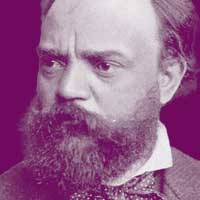Antonin Dvorak Biography - A Very Quick Guide
Artist:
Antonin Dvorak
Born:
1841, Nelahozeves, Bohemia
Died:
1904, Prague
Who Was Antonín Dvoøák?
Antonín Dvoøák (1841–1904) was a Czech composer known for combining classical forms with the folk melodies and rhythms of his native Bohemia. His music is admired for its clarity, strong sense of melody, and seamless integration of national elements. Dvoøák became internationally recognized during his lifetime and is now regarded as one of the major composers of the late Romantic period.
What Is Dvoøák Most Famous For?
Dvoøák is best known for:
Symphony No. 9, “From the New World” (1893), written during his stay in the United States.
The Slavonic Dances (1878, 1886), energetic orchestral pieces inspired by Czech and other Slavic dance forms.
Cello Concerto in B minor (1895), one of the most important works in the cello repertoire.
American String Quartet and American String Quintet, composed in Spillville, Iowa.
Rusalka (1901), a widely performed opera featuring the aria “Song to the Moon.”
He also wrote chamber music, choral works, songs, and numerous symphonies and concertos.
What Inspired Dvoøák’s Music?
Dvoøák’s music was shaped by:
Bohemian and Moravian folk music, especially dances like the furiant and dumka.
The Austro-German classical tradition, especially Brahms, who supported his career.
His strong interest in national identity during a period of Czech cultural revival.
During his American period, spirituals and Native American melodies, which he encouraged American composers to study, though he used original themes in his own works.
His approach combined national character with solid classical structure.
When Was Dvoøák Born?
Dvoøák was born on September 8, 1841, in Nelahozeves, a village near Prague in what is now the Czech Republic. He trained initially as a village musician and later studied at the Prague Organ School before working as a violist and teacher while developing his compositions.
How Did Antonín Dvoøák Die?
Dvoøák died on May 1, 1904, in Prague, at the age of 62. The cause was a stroke. He was already a nationally celebrated figure in Bohemia, and his death was widely mourned.
10 Facts About Antonín Dvoøák
Antonín Dvoøák (1841–1904) was a Czech composer known for combining classical forms with the folk melodies and rhythms of his native Bohemia. His music is admired for its clarity, strong sense of melody, and seamless integration of national elements. Dvoøák became internationally recognized during his lifetime and is now regarded as one of the major composers of the late Romantic period.
What Is Dvoøák Most Famous For?
Dvoøák is best known for:
What Inspired Dvoøák’s Music?
Dvoøák’s music was shaped by:
When Was Dvoøák Born?
Dvoøák was born on September 8, 1841, in Nelahozeves, a village near Prague in what is now the Czech Republic. He trained initially as a village musician and later studied at the Prague Organ School before working as a violist and teacher while developing his compositions.
How Did Antonín Dvoøák Die?
Dvoøák died on May 1, 1904, in Prague, at the age of 62. The cause was a stroke. He was already a nationally celebrated figure in Bohemia, and his death was widely mourned.
10 Facts About Antonín Dvoøák
- He supported himself early in life by playing viola in theatre orchestras.
- Brahms played a significant role in promoting his music to publishers and conductors.
- Dvoøák directed the National Conservatory of Music in New York from 1892 to 1895.
- He believed America should build a national style based on African American and Native American music.
- The famous English horn solo in the New World symphony was inspired by his longing for home.
- He wrote nine symphonies, though earlier ones were originally numbered differently.
- Dvoøák had a strong interest in trains and spent hours watching them for relaxation.
- His Slavonic Dances became a major international success almost immediately.
- Rusalka is his most frequently performed opera today.
- Many of his works draw on the dumka–furiant contrast, alternating melancholy and lively dance rhythms.
Top Pieces on 8notes by Antonin Dvorak
